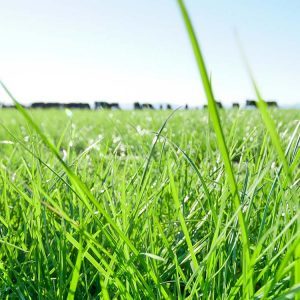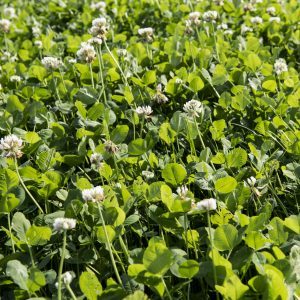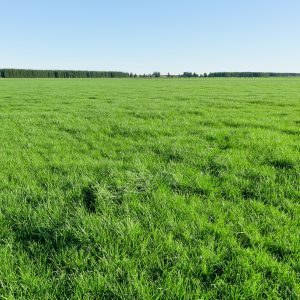Canterbury dairy farmer Vaughan Jones hasn’t escaped the record-breaking dry conditions plaguing parts of the country, but resilient pasture has helped to bridge the feed gap.
Vaughan’s 300-hectare dairy and 270-hectare cropping farm is near Rakaia. His coastal property is 30 metres above sea level with a flat topography.
The region is experiencing soil moisture deficits on the back of a very dry summer, however Vaughan’s pasture has continued to persist under irrigation.
“We are lucky as we are irrigating 15mm once a week on the dairy platform, with very fertile, silt loam soil. But conditions are still very dry,” says Vaughan.
“I was 20 metres behind the irrigator recently, and I dug down to three inches and it was bone dry. The pasture has managed to hold on, and we have seen good growth.”
Vaughan has used Germinal’s AberLasting clover with AberMagic and AberGreen High Sugar Grasses for the past seven years. Pasture renewal is completed in spring, as cows are wintered on-farm using fodder beet.
“We renew about 15 percent of our pasture every year,” says Vaughan.
“We only use one grass seed variety per mix, and don’t blend. I find it easier to manage the seeding dates and characteristics of pure swards, as I don’t have multiple characteristics in one paddock. It is not standard practice, but I have been doing this for at least 10 years with good results.”
The key difference with Germinal pasture is its persistence, he says.
“Growth is consistent. Some varieties continue to go to seed, whereas Germinal pasture stays in leaf with very good autumn and summer growth. It is highly palatable and persistent pasture, and cows really enjoy grazing it.”
AberLasting – an innovative cross of Caucasian and white clover – continues to persist six years after it was planted.
“AberLasting is a very competitive clover, which you can’t say about other clovers out there. The paddock is six years old now and still thriving. I am a big fan of pastures that last.”
Farm Facts:
- 570 hectares (1,408 acres)
- Milking 1,100 cows
- 5316 litres per cow per year at 4.87% fat and 3.84% protein
- 470 kg milk solids per cow per year
Related
Germinal’s High Sugar Grass ranked as key profit driver
Clover’s significance increases in wake of new regulations
New energy-dense, non-GMO ryegrass being developed for NZ



